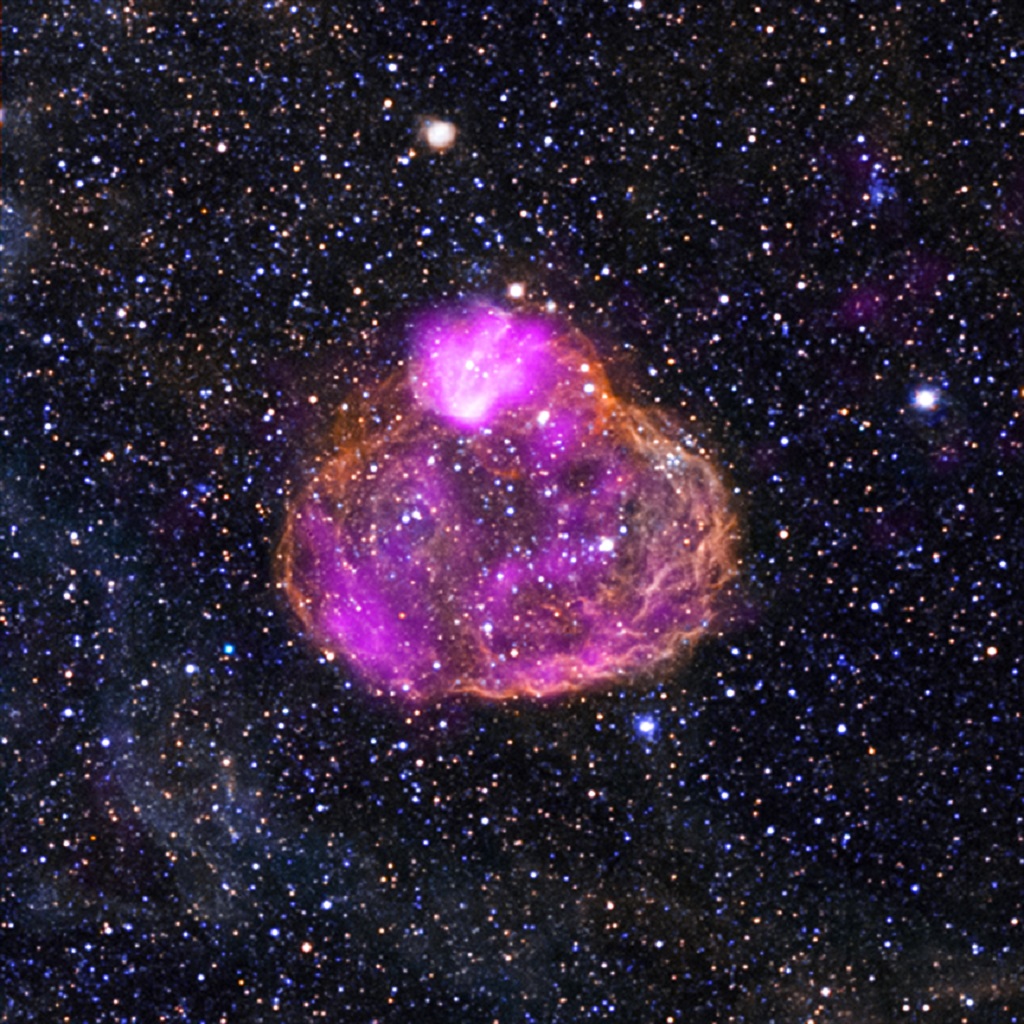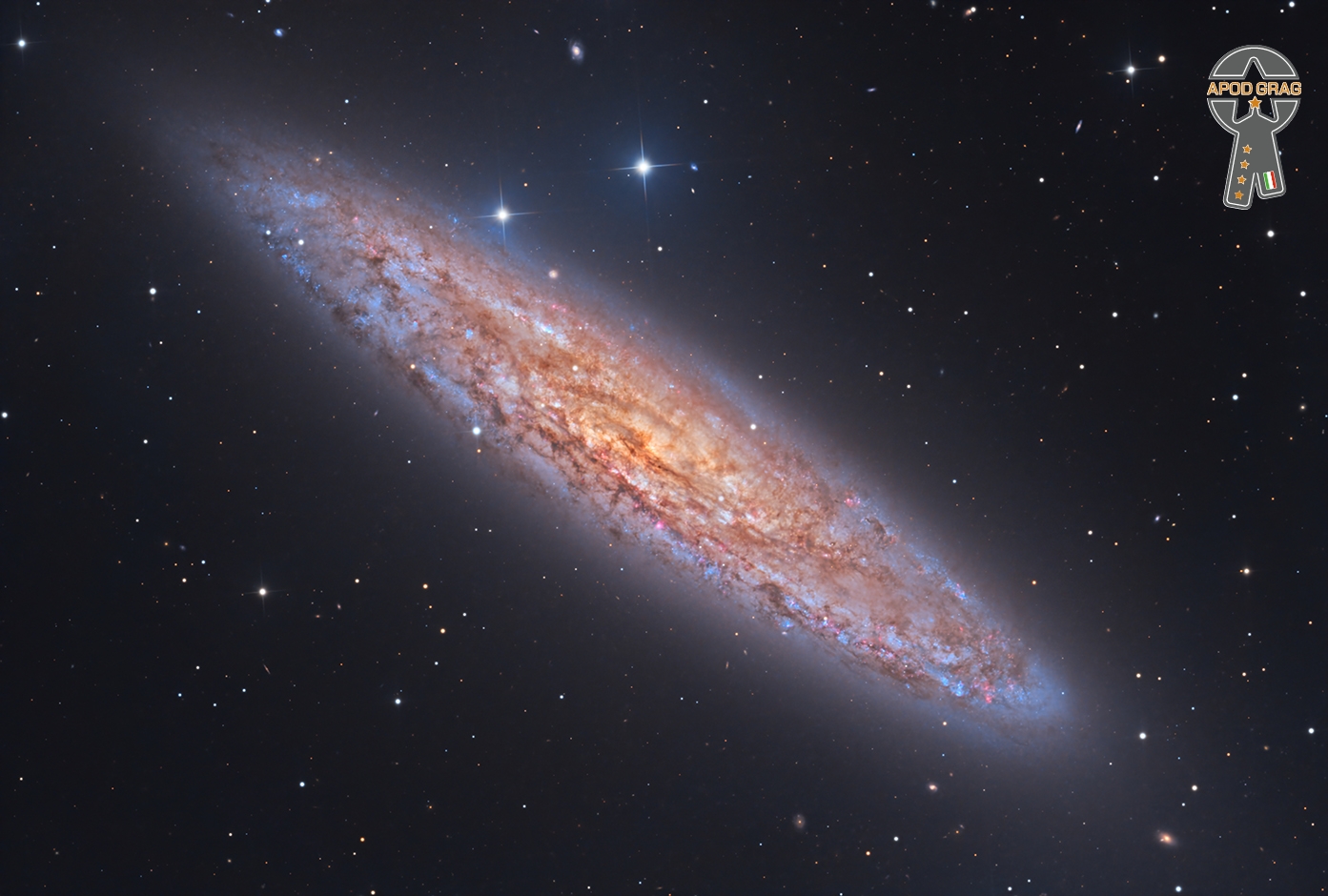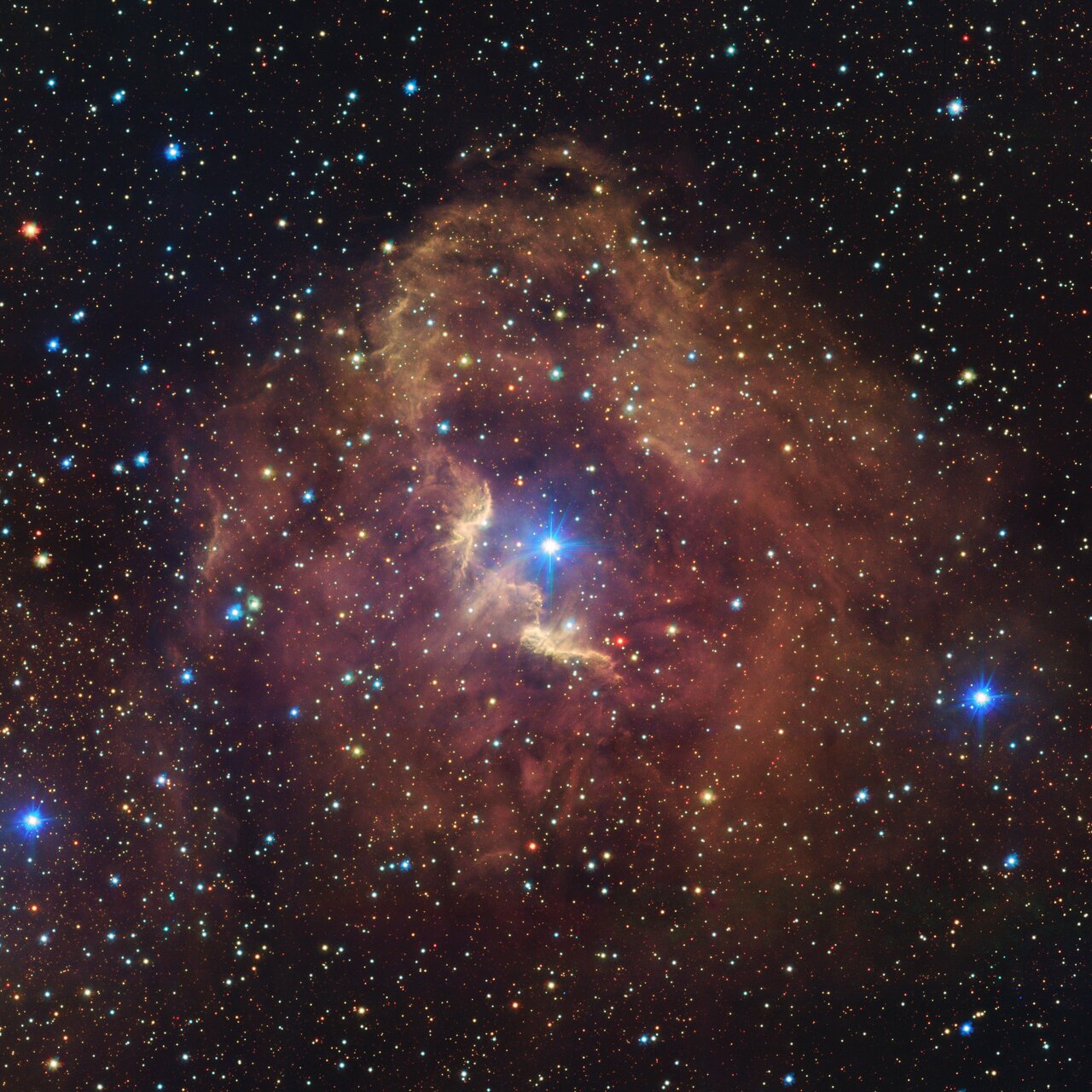Blog
Annapurna Devi (17 April 1927 – 13 October 2018) was an Indian surbahar player of Hindustani classical music. She was given the name ‘Annapurna’ by Maharaja Brijnath Singh of the former Maihar Estate (M.P.), and it was by this name that she was popularly known. She was the daughter and disciple of Allauddin Khan, and the sister of Ustad Ali Akbar Khan. Pandit Ravi Shankar was her first husband, with whom she had a son, Shubhendra Shankar, who was an artist and a sitaritst.
She was an extremely private person and was never interested in being a professional musician like the rest of her family. However, she was active throughout her life as a teacher to many other prominent musicians like Nikhil Banerjee, Hariprasad Chaurasia, and Nityanand Haldipur. She was the only known female maestro of the Surbahar in the 20th century.
more...This composite image shows the superbubble DEM L50 (a.k.a. N186) located in the Large Magellanic Cloud about 160,000 light years from Earth. Superbubbles are found in regions where massive stars have formed in the last few million years. The massive stars produce intense radiation, expel matter at high speeds, and race through their evolution to explode as supernovas. The winds and supernova shock waves carve out huge cavities called superbubbles in the surrounding gas. X-rays from NASA’s Chandra X-ray Observatory are shown in pink and optical data from the Magellanic Cloud Emission Line Survey (MCELS) are colored in red, green and blue. The MCELS data were obtained with the University of Michigan’s 0.9-meter Curtis Schmidt telescope at Cerro Tololo Inter-American Observatory (CTIO). The shape of DEM L50 is approximately an ellipse, with a supernova remnant named SNR N186 D located on its northern edge.
Like another superbubble in the LMC, N44, DEM L50 gives off about 20 times more X-rays than expected from standard models for the evolution of superbubbles. A Chandra study published in 2011 showed that there are two extra sources of the bright X-ray emission: supernova shock waves striking the walls of the cavities, and hot material evaporating from the cavity walls.
The Chandra study of DEM L50 was published in the Astrophysical Journal in 2011 and was led by Anne Jaskot from the University of Michigan in Ann Arbor. The Chandra study of DEM L50 was led by Anne Jaskot from the University of Michigan in Ann Arbor. The co-authors were Dave Strickland from Johns Hopkins University in Baltimore, MD, Sally Oey from University of Michigan, You-Hua Chu from University of Illinois and Guillermo Garcia-Segura from Instituto de Astronomia-UNAM in Ensenada, Mexico.

Matima Kinuani Mpiosso April 14th 1951-1996 Zairian Guitarist and leader of the group Za’iko Langa Langa which he formed while he was in school. He combined Zairian folk tunes with rock to produce an original sound that was popular in Europe and Japan. Arthritis stopped him from playing before his early death.
more...Eugene “Jug” Ammons (April 14, 1925 – August 6, 1974), also known as “The Boss”, was an American jazz tenor saxophonist. The son of boogie-woogie pianist Albert Ammons, Gene Ammons is remembered for his accessible music, steeped in soul and R&B.
Born in Chicago, Illinois, Ammons studied music with instructor Walter Dyett at DuSable High School. Ammons began to gain recognition while still at high school when in 1943, at the age of 18, he went on the road with trumpeter King Kolax‘s band. In 1944, he joined the band of Billy Eckstine (who bestowed on him the nickname “Jug” when straw hats ordered for the band did not fit), playing alongside Charlie Parker and later Dexter Gordon. Performances from this period include “Blowin’ the Blues Away,” featuring a saxophone duel between Ammons and Gordon. After 1947, when Eckstine became a solo performer, Ammons then led a group, including Miles Davis and Sonny Stitt, that performed at Chicago’s Jumptown Club. In 1949, Ammons replaced Stan Getz as a member of Woody Herman‘s Second Herd, and then in 1950 formed a duet with Sonny Stitt.
more...Ali Akbar Khan (14 April 1922 – 18 June 2009) was an Indian Hindustani classical musician of the Maihar gharana, known for his virtuosity in playing the sarod. Trained as a classical musician and instrumentalist by his father, Allauddin Khan, he also composed numerous classical ragasand film scores. He established a music school in Calcutta in 1956, and the Ali Akbar College of Music in 1967, which moved with him to the United States and is now based in San Rafael, California, with a branch in Basel, Switzerland.
Khan was instrumental in popularizing Indian classical music in the West, both as a performer and as a teacher. He first came to America in 1955 on the invitation of violinist Yehudi Menuhinand later settled in California. He was a Distinguished Adjunct Professor of Music at the University of California, Santa Cruz.
Khan was accorded India’s second highest civilian honour, the Padma Vibhushan, in 1989.[4]Nominated five times for the Grammy Award, Khan was also a recipient of the MacArthur Fellowship and the National Endowment for the Arts‘ National Heritage Fellowship.
more...The Sculptor Galaxy (also known as the Silver Coin Galaxy, Silver Dollar Galaxy, NGC 253, or Caldwell 65) is an intermediate spiral galaxy in the constellation Sculptor. The Sculptor Galaxy is a starburst galaxy, which means that it is currently undergoing a period of intense star formation.

Albert Leornes Greene (born April 13, 1946), known professionally as Al Green, is an American singer, songwriter, pastor and record producer best known for recording a series of soul hit singles in the early 1970s, including “Take Me to the River“, “Tired of Being Alone“, “I’m Still in Love with You“, “Love and Happiness“, and his signature song, “Let’s Stay Together“. After his girlfriend died by suicide, Green became an ordained pastor and turned to gospel music. He later returned to secular music.
Green was inducted into the Rock and Roll Hall of Fame in 1995. He was referred to on the museum’s site as being “one of the most gifted purveyors of soul music”. He has also been referred to as “The Last of the Great Soul Singers”. Green is the winner of 11 Grammy Awards, including the Grammy Lifetime Achievement Award. He has also received the BMI Icon award and is a Kennedy Center Honors recipient. He was included in the Rolling Stone list of the 100 Greatest Artists of All Time, ranking at No. 65, as well as its list of the 200 Greatest Singers of All Time, at No. 10.
more...Lowell Thomas George (April 13, 1945 – June 29, 1979) was an American singer, songwriter, multi-instrumentalist, and record producer, who was the primary guitarist, vocalist, songwriter and founder/leader for the rock band Little Feat.
Lowell George was born in Los Angeles, California, the son of Willard H. George, a furrier who raised chinchillas and supplied furs to the movie studios.
George led an overindulgent lifestyle of binge eating, alcoholism and speedballs (heroin and cocaine mixed together), and he became morbidly obese in the last years of his life, weighing 308 pounds (140 kg/22 stone). On June 15, 1979, George began a tour in support of his solo album, Thanks I’ll Eat it Here. On June 29, the morning after an appearance at Washington, D.C.’s Lisner Auditorium, where the bulk of Waiting for Columbus had been recorded in 1977, George collapsed and died of a heart attack in his Arlington, Virginia, hotel room at the Twin Bridges Marriott.
more...John William Casady (born April 13, 1944) is an American bass guitarist, best known as a member of Jefferson Airplane and Hot Tuna. Jefferson Airplane became the first successful exponent of the San Francisco Sound. Singles including “Somebody to Love” and “White Rabbit” charted in 1967 and 1968. Casady, along with the other members of Jefferson Airplane, was inducted into the Rock and Roll Hall of Fame in 1996.
Casady was born in Washington D.C., the son of Mary Virginia (née Quimby) and William Robert Casady. His father was of half Irish Protestant and half Polish Jewish ancestry. His mother was a relative of aviator Harriet Quimby; some of her family had been in North America since the 1600s.
more...Lawrence “Bud” Freeman (April 13, 1906 – March 15, 1991) was an American jazz musician, bandleader, and composer, known mainly for playing tenor saxophone, but also the clarinet.
In 1922, Freeman and some friends from high school formed the Austin High School Gang.Freeman played the C melody saxophone with band members such as Jimmy McPartland and Frank Teschemacher. before switching to tenor saxophone two years later. The band was influenced by the New Orleans Rhythm Kings and Louis Armstrong. While Armstrong was in King Oliver‘s Creole Jazz Band, Freeman attended performances at Lincoln Gardens with McPartland. They were nicknamed “Alligators”.
more...Friday April 12th 2024. 6:00 p.m. Erev Shabbat Service Celebrating the Rappaport Family, Recipients of the Gainsley Award, and Temple Israel’s Gold LEED Certification. Music with Inbal Sharett-Singer, Jayson Rodovsky, Jeff Bailey, Pete Whitman and mick laBriola.
more...
Located in the picturesque southern constellation of Centaurus, the Gum 41 nebula takes up most of this image brought to you by the VLT Survey Telescope, hosted at ESO’s Paranal Observatory in Chile. Let’s take a closer look at this intricate structure.
Set against a colorful backdrop of stars, Gum 41 is a pleasantly symmetric example of a Strömgren sphere: a shell of hydrogen gas atoms glowing in rosy hues due to the radiation of the dazzling central star. While this star, called HD 100099, may appear to be one very bright object, it is actually thought to be two young, massive stars orbiting in such a tight embrace that they cannot be separated at the scale of this image.
This romantic region is home to many pairs like this, including the luminous object on the lower right outskirts of the nebula, HD 99944. Sadly, the love story in these stellar couples will have a tragic ending: unlike our Sun, these hot and massive stars tend to have short lifetimes of only a few million years, and eventually there will be no young stars left to make the nebula glow. One day, Gum 41 will fade into transparency and be lost to future astronomers forever.
Gum 41 is also a member of a much larger region, affectionately called the Running Chicken Nebula. Whether Gum 41 forms the foot or the head of the chicken is surprisingly controversial.

Herbert Jeffrey Hancock (born April 12, 1940) is an American jazz musician, bandleader, and composer. Hancock started his career with trumpeter Donald Byrd‘s group. He shortly thereafter joined the Miles Davis Quintet, where he helped to redefine the role of a jazz rhythm section and was one of the primary architects of the post-bop sound. In the 1970s, Hancock experimented with jazz fusion, funk, and electrostyles, using a wide array of synthesizers and electronics. It was during this period that he released perhaps his best-known and most influential album, Head Hunters.
Hancock’s best-known compositions include “Cantaloupe Island“, “Watermelon Man“, “Maiden Voyage“, and “Chameleon“, all of which are jazz standards. During the 1980s, he enjoyed a hit single with the electronic instrumental “Rockit“, a collaboration with bassist/producer Bill Laswell. Hancock has won an Academy Award and 14 Grammy Awards, including Album of the Year for his 2007 Joni Mitchell tribute album River: The Joni Letters.
Since 2012, Hancock has served as a professor at the University of California, Los Angeles, where he teaches at the UCLA Herb Alpert School of Music. He is also the chairman of the Herbie Hancock Institute of Jazz (known as the Thelonious Monk Institute of Jazz until 2019).
Hancock was born in Chicago, the son of Winnie Belle (née Griffin), a secretary, and Wayman Edward Hancock, a government meat inspector. His parents named him after the singer and actor Herb Jeffries.He attended Hyde Park High School. Like many jazz pianists, Hancock started with a classical education. He started playing piano when he was seven years old, and his talent was recognized early. Considered a child prodigy, he played the first movement of Mozart‘s Piano Concerto No. 26 in D Major, K. 537 (Coronation) at a young people’s concert on February 5, 1952, with the Chicago Symphony Orchestra (led by CSO assistant conductor George Schick) at age 11.
more...James D. “Shakey Jake” Harris (April 12, 1921 – March 2, 1990) was an American Chicago blues singer, harmonicist and songwriter. He released five albums over a period of almost 25 years. He was often musically associated with his nephew Magic Sam.
James D. Harris was born in Earle, Arkansas, and relocated with his family to Chicago, Illinois, at the age of seven. He played in several Chicago blues ensembles in the late 1940s. He also worked as a mechanic and as a professional gambler (his nickname came from a dice players’ expression, “shake ’em”). His debut recording was the single “Call Me if You Need Me”, backed with “Roll Your Moneymaker”, released by Artistic Records in 1958, featuring Magic Sam and Syl Johnson on guitar and produced by Willie Dixon. Harris was not paid for the session, but he won $700 shooting craps with label owner Eli Toscano.
more...